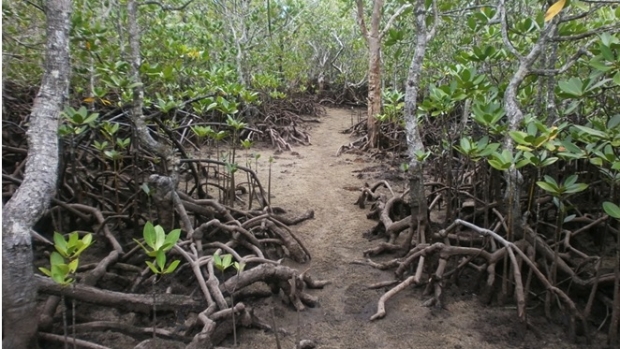Grants :: Medium Grant Facilities :: Community-based management of the Port Launay Mangrove Ramsar Site in Seychelles
Community-based management of the Port Launay Mangrove Ramsar Site in Seychelles

The proposed route for the Port Launay mangrove boardwalk in ... , Mahe. Seychelles © MFF, 2014
Objectives
The project aims to introduce community-based measures for management of the Port Launay Mangrove Ramsar site.
Background
Mangrove wetlands are widely recognized to be valuable eco-systems, contributing to the health of coastal ecosystems by filtering sediments and other run off from the land, providing nursery space for many coral reef species, and also acting as a buffer to protect the coast from storms and the impacts of climate change (including storm surges, sea level rise and erosion). The Port Launay Mangrove is located on the north west coast of the island of Mahe in Seychelles, and remains the best remaining example of a healthy mangrove forest in the granitic islands. Although the Port Launay Mangrove was declared Seychelles’ first Ramsar site in 2007, the management of this site had never been clearly allocated to any one organisation and so the welfare of the site was left to chance. Approximately 2/3 of the mangrove falls within the boundaries of the Constance Ephelia Resort of Seychelles (CERS) and the remainder falls within the community, mostly bordering on private properties. Ultimately, responsibility for the mangrove wetland falls under the jurisdication of the Ministry of Environment and Energy (MEE). The main problems facing the Port Launay wetland include littering and illegal dumping, encroachment and infilling along the borders, and dieback of mangroves in one area within the resort boundary. In 2011, CERS and Sustainability for Seychelles (S4S) received a GEF grant through the government of Seychelles to develop a co-management plan for the site, with the MEE, the community, and the resort as key implementers of the plan. The management plan is now complete and ready for implementation. The management plan addresses several issues: monitoring of biodiversity and mangrove health, mangrove restoration, involvement of community, education & awareness, and exploration of potential sustainable economic activities that could provide direct benefits to the community in terms of increased income and improved livelihoods, as well as improved resilience in the face of climate change.
The resort, the community, and other partners are willing to commit volunteer time and resources to help with implementation, but there is a need for someone to take the lead, and this would ideally be the newly formed community-based organization Port Glaud Environment Club, set up with the support of a previous S4S small grant from MFF. The Port Glaud Environment Club does not yet have the capacity to do this, and all partners have agreed that S4S should assist and help them develop the skills to take on a more active role in co-managing the wetland.
Target beneficiaries
The main beneficiary of this project will be the community organization, PORT GLAUD ENVIRONMENT CLUB and its members. The club currently has about forty members, over half of them youth. The project will help them to further strengthen their organisation and gain new active members (from various age groups and both genders) who are committed to working together for their community and the conservation of the mangrove forest. Other beneficiaries will include:
- The Ministry of Environment and Energy – who currently have limited resources to monitor and protect the mangrove and implement the management plan of the Ramsar Site.
- The Port Launay mangrove itself – will be monitored for changes due to human activities, the degraded area will be restored, and degrading human activities on the fringes will be halted.
- Potential entrepreneurs – in Port Glaud will benefit from training opportunities and also from the CBO’s experiences/experiments with small sustainable business ideas.
Outputs
The project is designed to deliver these results:
- The Port Glaud community-based organization is strengthened to support management of the Ramsar Site.
- Sustainable businesses are introduced to support management of the Ramsar Site.
Project Facts
Country
Location
Port Glaud district, Mahe, Seychelles
Topic
Duration
1st Nov 2014 to 31st Oct 2016
MFF Grant Amount
SCR 1,142,160
Implementing Partner
Sustainability for Seychelles (S4S)
Ms Michele Martin, Executive Director
Ms Marie-Therese Purvis, Chairperson
Tel no: +248 422 4072